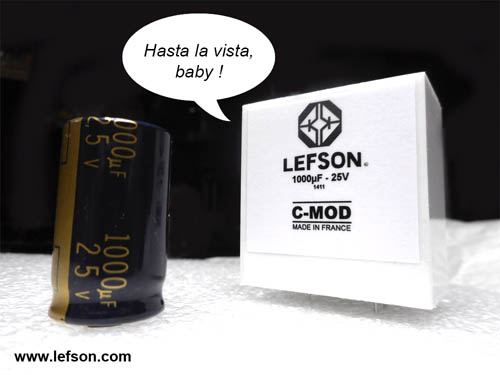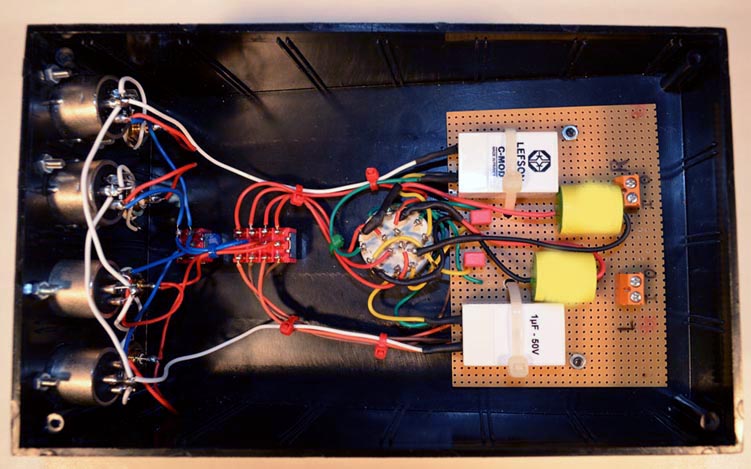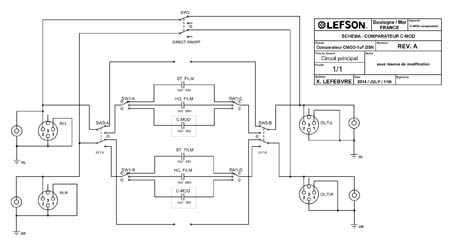

The LEFSON C-MOD is a very high performance audio coupling module. It’s named «coupling module» instead of «capacitor» because it was designed
with care in the point of view of an audio coupling system. Extremely low loss operation is one of its best features, this is our «WIRE LIKE» technology.
Specially designed to process small AC signals (instrument, microphone, line), the LEFSON C-MOD is the perfect solution when a DC blocking capacitor is needed,
in low voltage circuitries.
The LEFSON C-MOD is fitted with an internal shielding and can be placed in high magnetic flux environment. A dedicated clamp
(patent pending) can be optionally used to achieve a perfect mechanical ground.
Main features of the LEFSON C-MOD are :
- NON-POLAR CAPACITIVE MODULE
- «WIRE LIKE» TECHNOLOGY : EXTREMELY LOW LOSS
- INTERNAL SHIELDING
- HIGH CAPACITANCE VALUES / SMALL SIZE
- SUITABLE IN HIGH MAGNETIC FLUX ENVIRONMENT
The LEFSON C-MOD is non-polar : both audio pins can be either used as input or output for analog signal. It is designed to be used as a precision
audio coupling module. The LEFSON C-MOD is sold with a 20 hours burn-in time. To achieve optimum results, it needs to be burned-in with audio signals during at least 80 hours.
We designed 16 values, from 1µF to 1000µF working at low DC voltage (25V/35V/50V), as follows :
| CAP.(µF) | VDC | CASE | REF. | PRICE |
|---|---|---|---|---|
| 1 | 50V | A | C1M50 | 77€ |
| 2.2 | 50V | A | C2M250 | 80€ |
| 3.3 | 50V | A | C3M350 | 83€ |
| 4.7 | 50V | A | C4M750 | 85€ |
| 10 | 50V | A | C10M50 | 87€ |
| 22 | 35V | A | C22M35 | 93€ |
| 22 | 50V | B | C22M50 | 97€ |
| 33 | 50V | B | C33M50 | 101€ |
| 47 | 50V | B | C47M50 | 106€ |
| 100 | 50V | B | C100M50 | 114€ |
| 220 | 35V | B | C220M35 | 120€ |
| 220 | 50V | C | C220M50 | 131€ |
| 330 | 25V | B | C330M25 | 128€ |
| 330 | 50V | C | C330M50 | 140€ |
| 470 | 35V | C | C470M35 | 151€ |
| 1000 | 25V | C | C1000M25 | 168€ |
Recommended retail price
- The ideal audio coupling
Ideally, we shouldn’t have to use any capacitor to design an audio coupling. They cause, because of their properties, a variable ratio of losses of any AC signal that runs them. The best capacitor should be « no capacitor ».
The preservation and stability of DC polarization voltages between electronic stages sometimes forces the designer to use an audio coupling capacitor.
The purpose of the LEFSON C-MOD is clear : get closer to the quality of a direct (wire) coupling.
- Measures with Pure Tones
Traditional measures using a pure tone show that the LEFSON C-MOD has quite standard characteristics.
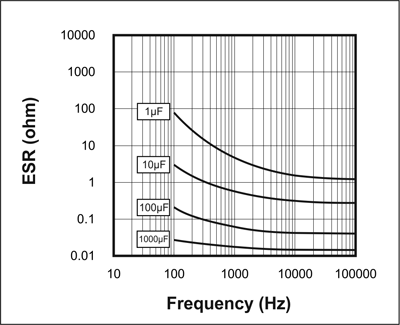
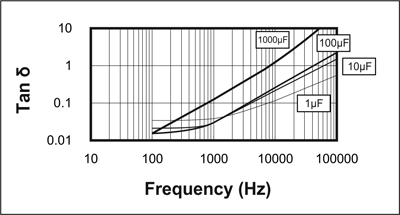
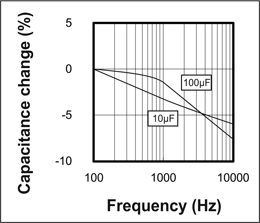
We can notice the ESR (Equivalent Serie Resistance) consistency and the linearity of the dissipation factor (Tan δ) between 10kHz and 100kHz. But that’s when it’s used with complex or musical signals that the LEFSON C-MOD, with its « WIRE LIKE » technology, brings its incredible performances.
- Measures with Complex Signal
In the audio area, except the « R2D2 » robot, nobody listens to pure tones. These are mainly used as references during calibration, adjustment and measurement procedures.
99,9% of musical signals are of a complex type : several waveforms of different levels and frequencies are mixed to form an overall signal, said complex. An electronic component may have a very different behaviour according to
the type of signal it needs to process.
Since an audio coupling capacitor handles, in 99,9% of cases, musical signals, thus complex, it’s to them that its behaviour must be beyond reproach. This is why we designed the LEFSON C-MOD as an audio coupling module for
complex signals and not as a classic capacitor.
- Measurement method
It’s possible to mesure the result of a complex or musical signal through different capacitors. We can use a spectrum analyser, multimeter or oscilloscope. However, the nuances between components remaining relatively low with
regard to the effective signal level, it is difficult to aspire to a serious exploitation of statements and measures.
As shown in the picture below, the lack of precision of measuring instruments must be taken into account. In this example, two capacitors of 1µF and of different quality are nevertheless well processed by the same musical signal.
When listening, the high quality (HQ.) POLYPROPYLENE capacitor gives better impressions than the standard capacitor (ST .) POLYESTER.
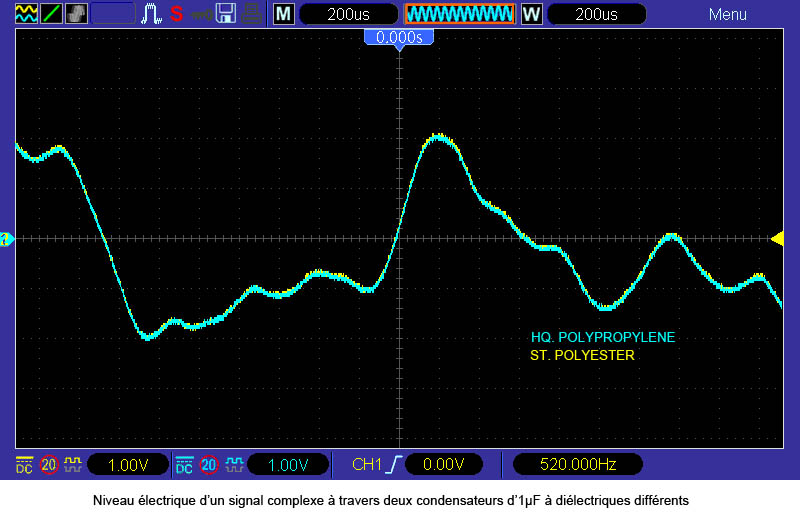
The most reliable method uses the phase reversal. If we add two strictly identical signals but of reversed phase, they nullify. For example, the two following signals are in phase reversal. Their theoretical sum is perfectly zero.
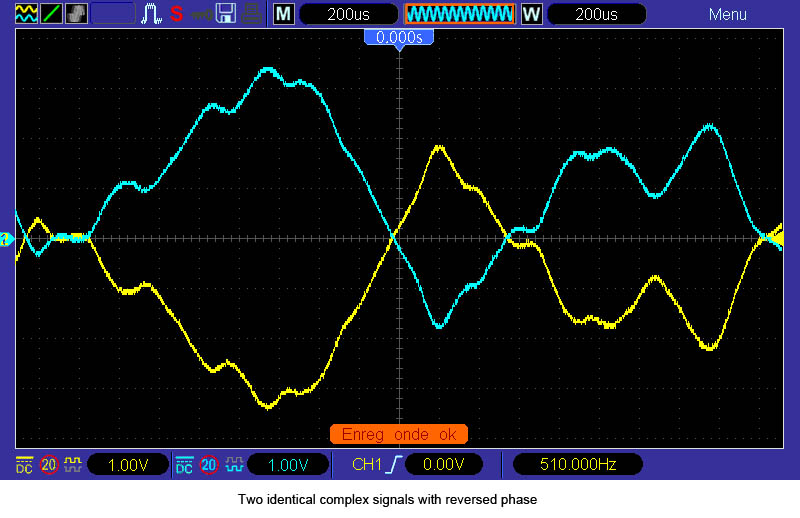
As a reference, we take a complex signal from a musical source. If we make it go through different capacitors (one by one) and also by a direct coupling (without capacitor), the capacitor causing less loss will be the one whose
addition in reverse phase with the direct coupling will give the weakest signal.
Similarly, if we add the signal obtained by the direct coupling whith its opposite in phase, the result will theoretically be null.
- Recording various signals
To proceed with the phase reversal method, we are going to record four musical samples from a common stereo source :
- DIRECT : Direct coupling, ideal capacitor (no capacitor)
- ST. POLYESTER : Standard quality film capacitor - 1µF/63V Metalized Polyester
- HQ. POLYPROPYLENE : High quality film capacitor - 1µF/200V Metalized Polypropylene
- C-MOD : LEFSON coupling module - 1µF/50V
We use the following configuration :
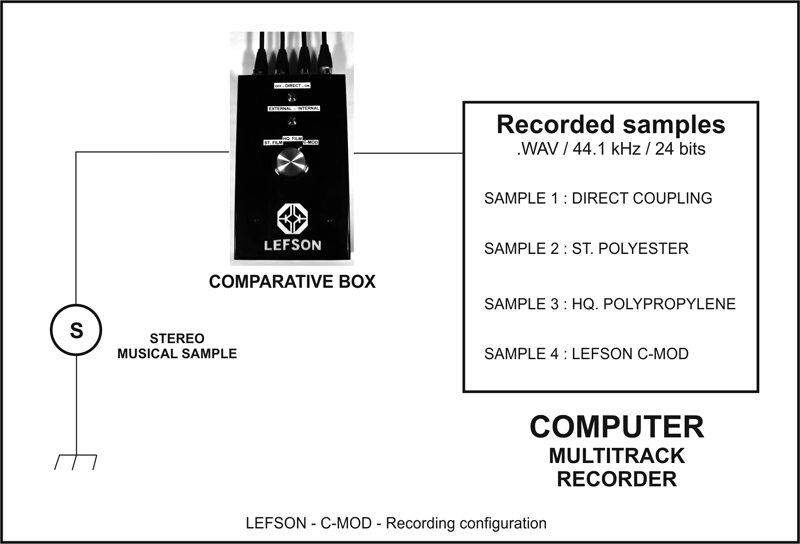
The four samples are recorded one by one after selection of the desired pair of capacitors. All recordings are made with the same wiring and on the same input of the digital multitrack recorder. The « LEFSON – Comparative Box » is a stereo comparator box for coupling capacitors. It consists only of sockets, rotary and lever switches. Below is a picture of the 1µF comparator box used for our tests, and its electronic schematic :
The recordings give nearly similar levels. Impossible to use the results at this level.
We select a very short period of music and proceed to four new internal recordings in the multitrack recorder, according to additions of signals with others, in phase reversal, as follows :
. DIRECT + ɸ(DIRECT) = -116.9 dBFS (peak)
. DIRECT + ɸ(C-MOD) = -60.5 dBFS (peak)
. DIRECT + ɸ(HQ. POLYPROPYLENE) = -57.6 dBFS (peak)
. DIRECT + ɸ(ST. POLYESTER) = -57.5 dBFS (peak)
At this point in our experience, we already understand that the LEFSON C-MOD causes a level of loss lower than the one of the two others. In order to view the results on the oscilloscope, we apply a digital amplification (Full Scale)
of gain Gfs=4 to each of the four previous recordings. So we get the following levels :
. DIRECT + ɸ(DIRECT) = -29.2 dBFS (peak)
. DIRECT + ɸ(C-MOD) = -15.1 dBFS (peak)
. DIRECT + ɸ(HQ. POLYPROPYLENE) = -14.4 dBFS (peak)
. DIRECT + ɸ(ST. POLYESTER) = -14.37 dBFS (peak)
- Visualization of loss levels on the oscilloscope
Each stereo recording is summed to a mono output channel connected to the oscilloscope input. The ideal capacitor (direct coupling/ no capacitor) is obviously the one which causes no loss. The displayed small wave is in fact the noise of the digital multitrack recorder.
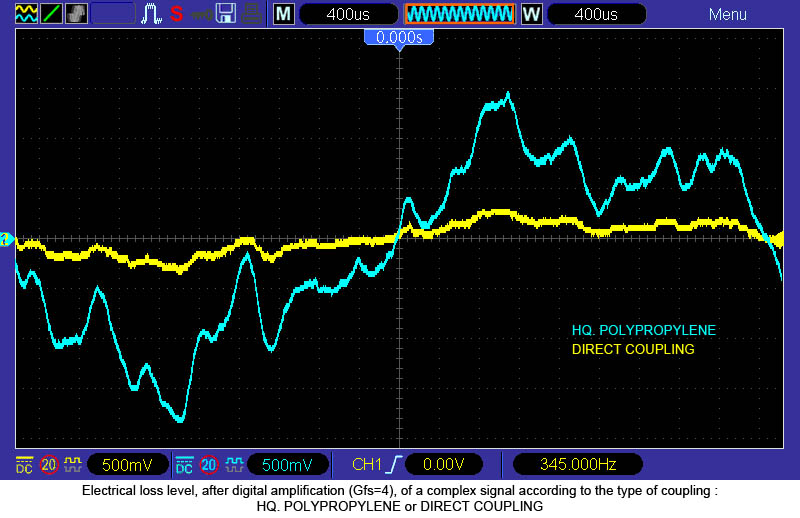
The ST. POLYESTER capacitor causes, depending on the period, slightly more losses than the H.Q POLYPROPYLENE.

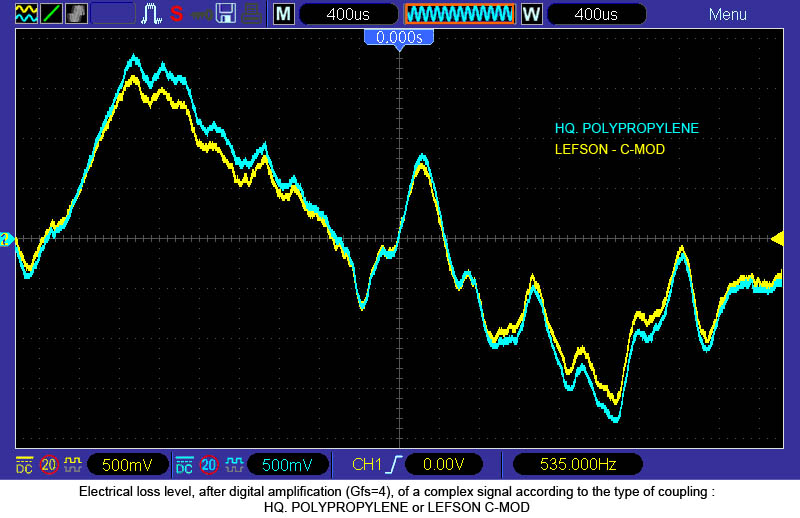

- When hearing meets measurement
Accuracy, detail, fastness of transients, dynamic conservation, are among the words pronounced by all the professional of sound, in audiophily and recording studio, who listened and compared the LEFSON C-MOD.
These hearing sensations directly come from the « WIRE LIKE » technology developed by LEFSON, that allows an ultra-low ratio of audio loss.
